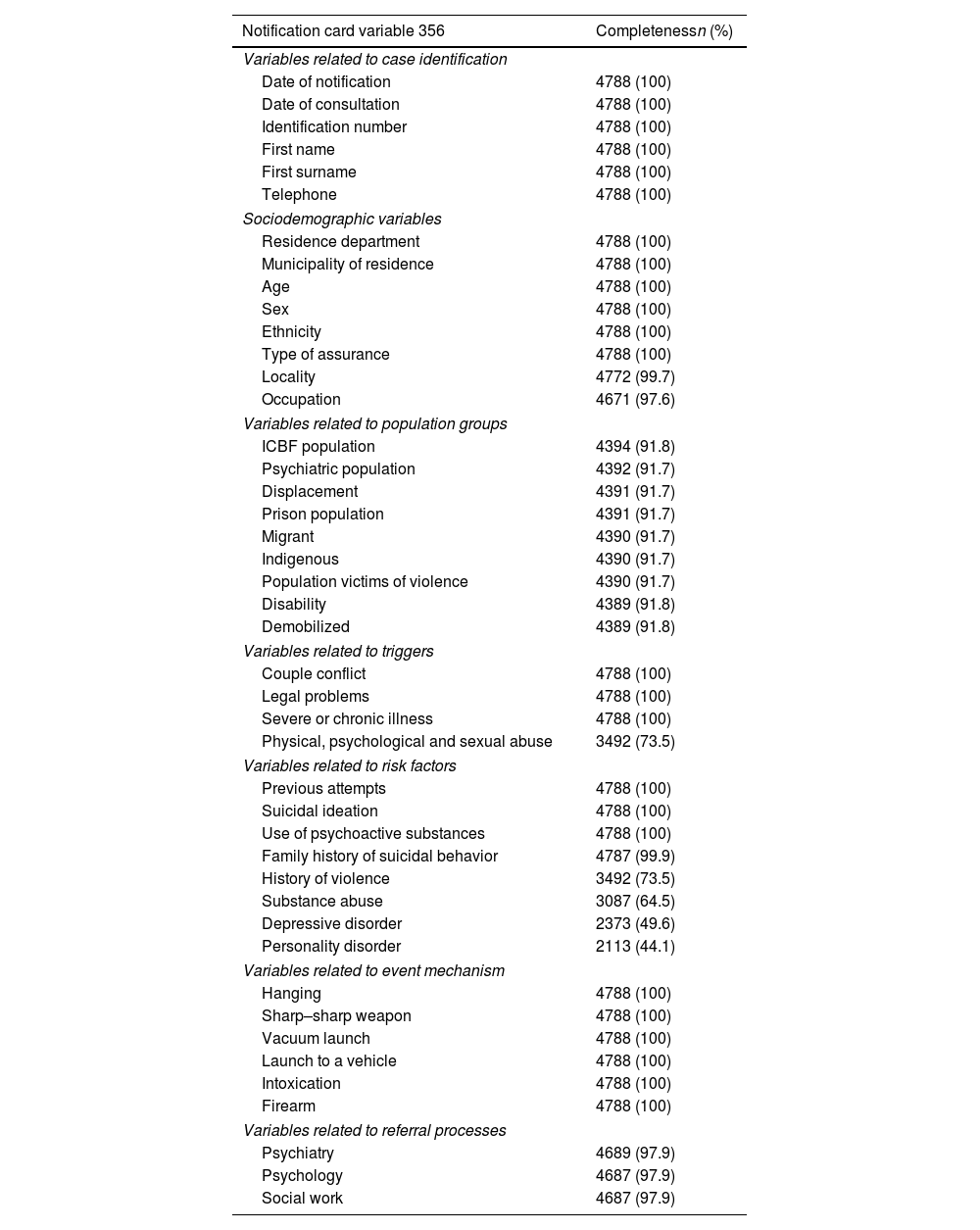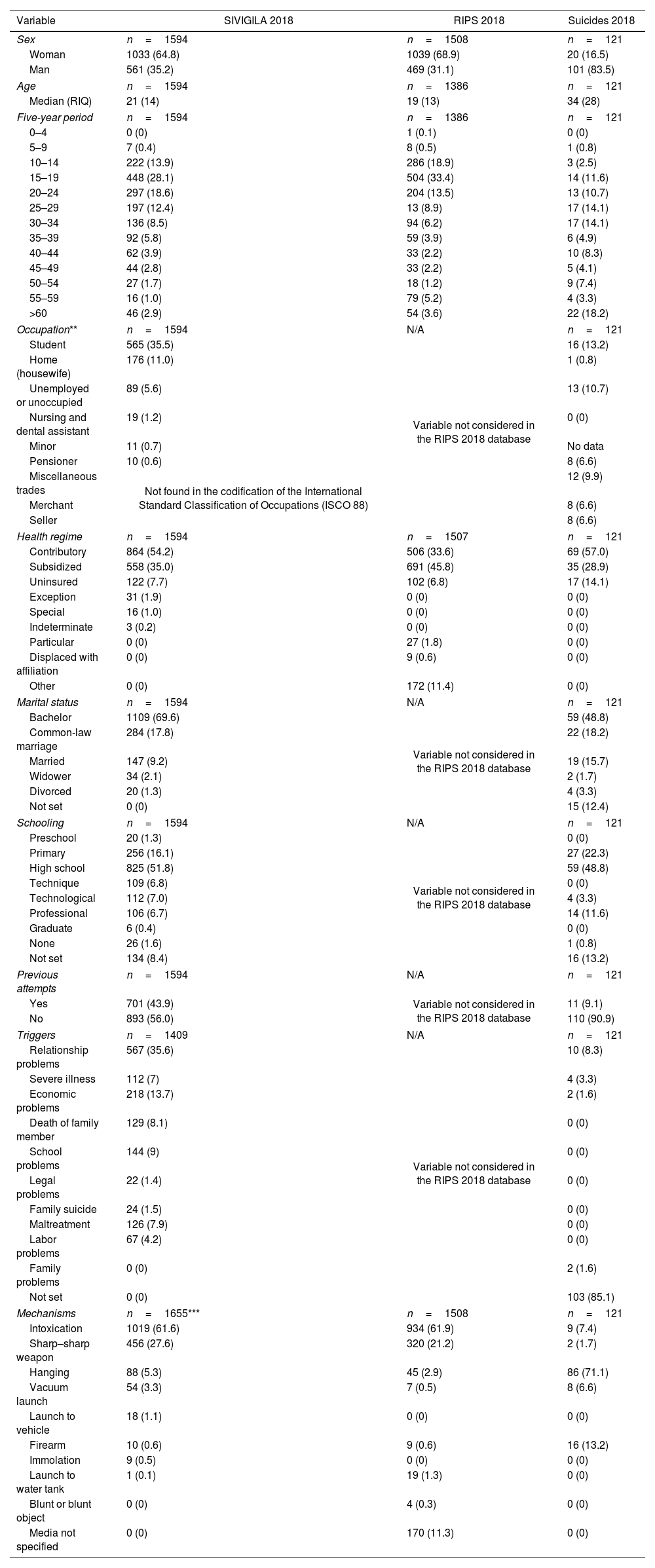Suicidal behaviors are one of the top ten causes of death worldwide. It is recommended to prioritize the surveillance of suicide attempts, as this is a useful risk factor in the short-term prediction of suicide. In Colombia, its surveillance was implemented in 2016. The study evaluated the performance of the suicide attempt surveillance system in Cali, Colombia, in the period 2016–2019.
Material and methodsThe attributes of timeliness, data quality and representativeness were evaluated according to the CDC Guidelines for Violence and Injury Surveillance, in addition to describing patterns of occurrence through time series.
ResultsThe median timeliness of notification was 0 days (RIQ=3). The variables exposure to violence (73.5%), depressive disorder (49.6%) and personality disorder (44.1%) had the highest percentages of missing data. The system identifies priority populations similar to other sources of information, such as young people between 15 and 24 years of age (28.1%), women (64.8%), students (35.5%) and the single population (69.6%); triggering factors such as relationship problems (35.6%), economic problems (13.7%) and serious illness (7%); and mechanisms used such as intoxication (61.6%), short stabbing weapon (27.6%) and hanging (5.3%). The system predicts 22 cases (95% CI=21.6–22.3) per week of attempted suicide in the short term.
ConclusionsThe system meets the attributes of quality, timeliness and representativeness. It also allows the identification of an expected threshold of cases that needs to be validated to detect outbreak situations. This study contributes to the knowledge and prevention of the suicidal phenomenon.
Las conductas suicidas son una de las 10 primeras causas de muerte en el mundo. Se recomienda priorizar la vigilancia del intento de suicidio, al ser este un factor de riesgo útil en la predicción a corto plazo del suicidio. En Colombia se implementó su vigilancia en el año 2016. El estudio evaluó el desempeño del sistema de vigilancia del intento de suicidio en Cali, Colombia, en el periodo 2016-2019.
Material y métodosSe evaluaron los atributos de oportunidad, calidad del dato y representatividad de acuerdo con la Guía para la vigilancia de violencias y lesiones de los Centros de Estados Unidos para el Control y la Prevención de Enfermedades (CDC), además de describir patrones de ocurrencia a través de series de tiempo.
ResultadosLa mediana de oportunidad de notificación fue de 0 días (RIQ=3); 54,5% de las variables se diligenciaron completamente; las variables de exposición a violencias (73,5%), trastorno depresivo (49,6%) y trastorno de la personalidad (44,1%) presentaron mayores porcentajes de datos faltantes. El sistema identifica poblaciones a priorizar similares a otras fuentes de información como jóvenes entre 15-24 años (28,1%), mujeres (64,8%), estudiantes (35,5%) y población soltera (69,6%); factores desencadenantes como problemas de pareja (35,6%), problemas económicos (13,7%) y enfermedad grave (7%); y mecanismos utilizados como intoxicaciones (61,6%), arma punzo cortante (27,6%) y ahorcamiento (5,3%). El sistema predice a corto plazo 22 casos (IC 95%=21,6-22,3) semanales de intento de suicidio.
ConclusionesEl sistema cumple con los atributos de calidad, oportunidad y representatividad. Permite, además, identificar un umbral esperado de casos que requiere ser validado para detectar situaciones de brote. Este estudio contribuye al conocimiento y a la prevención del fenómeno suicida.









